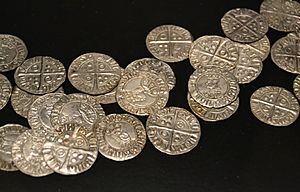Croat (coin) facts for kids
The croat was an important silver coin used in Catalonia, a region in what is now Spain. It was first made in 1285 by Peter III of Aragon, who was the King of Aragon and Count of Barcelona. These coins were minted, or made, in the city of Barcelona.
The name "croat" comes from a Latin phrase, grossus denarius, which means "great coin." This name was common for silver coins that were worth more than regular pennies. King Peter III got the idea for the croat from a similar coin called the gros, which was introduced by Louis IX of France.
Contents
What Was the Croat Coin?
The croat coin was a special type of money. It was made of silver and became very popular. It helped people buy and sell things across the Mediterranean Sea.
How the Croat Started
When the croat was first made, it was worth twelve terns. A tern was a smaller coin made of a mix of silver and other metals, called billon. This billon was about 25% silver.
Later, in 1340, a new gold coin called the florín was introduced. One florín was worth eleven croats. By 1365, the florín's gold purity was set at eighteen carats, meaning it was 75% pure gold.
Croat's Value and Importance
As both the florín and the croat became widely used, the Aragonese empire started using a system called bimetallism. This means they used both gold and silver coins as official money.
The Catalan croat had the same value as the Aragonese ral. The ral was known by many names, like grosso, real, alfonsino, and anfusinus. The croat was known for being very stable, meaning its value didn't change much. Because of this, it was used a lot in trade across the Mediterranean Sea.
Sources
See also
 In Spanish: Croat (moneda) para niños
In Spanish: Croat (moneda) para niños


